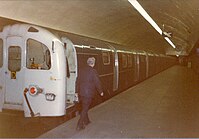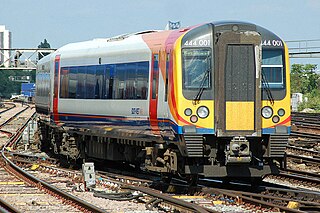
Stagecoach South Western Trains Limited, trading as South West Trains (SWT), was an English train operating company owned by Stagecoach, which operated the South Western franchise between February 1996 and August 2017.
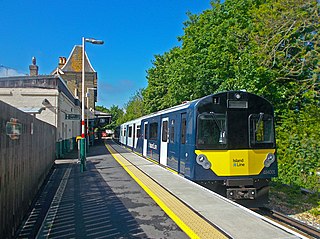
The Island Line is a railway line on the Isle of Wight which runs along the island's east coast and links Ryde Pier Head with Shanklin. Trains connect at Ryde Pier Head with passenger ferries to Portsmouth Harbour, and these ferries in turn connect with the rest of the National Rail network via the Portsmouth Direct Line. The line also connects to the Isle of Wight Steam Railway, a heritage railway, at Smallbrook Junction. For much of its length the line runs alongside the A3055, criss-crossing this road by means of the Ryde Tunnel and bridges at Rowborough, Morton Common, Lake Hill and Littlestairs.

Network SouthEast (NSE) was one of the three passenger sectors of British Rail created in 1982. NSE mainly operated commuter rail trains within Greater London and inter-urban services in densely populated South East England, although the network went as far west as Exeter and also covered the inner East of England. Before 1986, the sector was originally known as London & South Eastern.
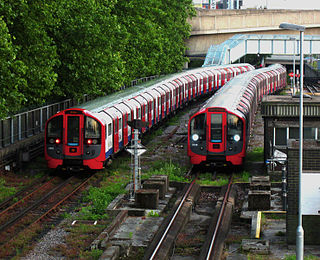
London Underground rolling stock includes the electric multiple-unit trains used on the London Underground. These come in two sizes, smaller deep-level tube trains and larger sub-surface trains of a similar size to those on British main lines, both running on standard gauge tracks. New trains are designed for the maximum number of standing passengers and for speed of access to the cars.

The London Underground 1938 Stock was a London Underground tube stock design. A total of 1,121 cars were built by Metro-Cammell and Birmingham RC&W. An additional 173 cars were added to the fleet by the end of 1953, comprising 91 new builds, 76 conversions from Pre-1938 Tube Stock or 1935 Tube Stock, and six unconverted cars of 1935 Tube Stock, and the stock was used on the London Underground until 1988. During their long lives they worked on the Bakerloo, Northern, Piccadilly, East London, Central, and Northern City lines. Ten sets were refurbished and ran on the Isle of Wight as Class 483, making them the oldest passenger rolling stock operating timetabled services on the National Rail network at the time of their withdrawal in January 2021.

The British Rail Class 483 electric multiple units were originally built as 1938 tube stock units for London Underground. They were extensively refurbished between 1989 and 1992 by Eastleigh Works, for use on services on the Isle of Wight's Island Line. This was despite having already been used for nearly 50 years on the London Underground network. The units replaced the even older and life-expired British Rail Classes 485 and 486 units which were introduced in 1967, but were originally built as 'Standard' stock units for the London Electric Railway in 1923.

The British Rail Class 485 and British Rail Class 486 electrical multiple units were originally built for the London Electric Railway from 1923-31 as its 'Standard' tube stock. They were purchased by British Rail in 1967 and transported to the Isle of Wight to work 'mainline' services on the newly electrified Ryde to Shanklin line, where they worked for an additional quarter of a century. At the time of their purchase the units had already worked for over 40 years on the London Underground, but their introduction allowed the last steam locomotives on the line to be withdrawn.

The London Underground 1992 Stock is a type of rolling stock used on the Central and Waterloo & City lines of the London Underground. A total of 85 eight-car trains were built for the Central line and 5 four-car trains were built for the Waterloo & City line.

The Standard Stock title was applied to a variety of Tube stock built between 1923 and 1934, all of which shared the same basic characteristics, but with some detailed differences. This design is sometimes referred to as 1923 Tube Stock, 1923 Stock, or Pre 1938 Stock. Most of the Standard Stock was built to replace the first generation of "Gate Stock" Tube trains or to provide additional trains for extensions built in the 1920s and early 1930s. Standard Stock cars consisted of motor cars, with a driver's cab, behind which was a "switch compartment" occupying approximately one-third of the length of the car, plus trailer cars and "control trailers", with a driving cab but no motor. All were equipped with air operated sliding doors. The guard's door on the earlier trains was a manually operated, inward-opening hinged door.

British Rail was the brand image of the nationalised railway owner and operator in Great Britain, the British Railways Board, used from 1965 until its breakup and sell-off from 1993 onwards.

The London Underground A60 and A62 Stock, commonly referred to as A Stock, was a type of sub-surface rolling stock which operated on the Metropolitan line of the London Underground from 12 June 1961 to 26 September 2012, and on the East London line from 1977 until 22 December 2007, when it closed to be converted into London Overground.
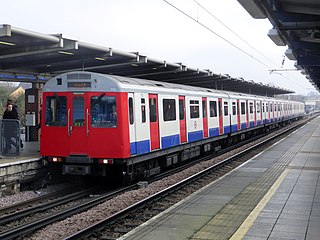
The London Underground D78 Stock, commonly referred to as D Stock, was a type of sub-surface rolling stock which operated on the District line of the London Underground, except on the Wimbledon to Edgware Road service. The first units were withdrawn in January 2015 with the last withdrawn on 21 April 2017.
The Southern Region was a region of British Railways from 1948 until 1992 when railways were re-privatised. The region ceased to be an operating unit in its own right in the 1980s. The region covered south London, southern England and the south coast, including the busy commuter belt areas of Kent, Sussex and Surrey. The region was largely based upon the former Southern Railway area.

Ryde Pier Head railway station is one of three stations in the town of Ryde on the Isle of Wight. Situated at the end of the town's pier, it is adjacent to the terminal for the Wightlink fast catamaran service connecting the island with Portsmouth on the English mainland. Passengers can use this to connect with the rest of the National Rail network at Portsmouth Harbour station, which is adjacent to the Portsmouth terminal. Through rail tickets for travel via Pier Head station are available to and from other stations on the Isle of Wight. These include travel on the catamaran service to or from Portsmouth as appropriate.

Island Line is a brand of South Western Railway which runs the 8.5-mile (13.7 km) Island Line on the Isle of Wight. A stand-alone franchise from 1996 until 2007, it then became part of the South Western franchise operated by South West Trains until August 2017 and since by South Western Railway.

Ryde Traincare Depot is a railway traction maintenance depot, situated in Ryde, Isle of Wight, to the east of Ryde St John's Road railway station. The depot is operated by Island Line, is allocated the Island Line fleet of the British Rail Class 484s. The depot code is RY.

There once existed a 55+1⁄2-mile (89.3 km) network of railway lines on the Isle of Wight, which operated both as a self-contained railway network, and as links to ferry services between the island and the South coast of Great Britain. The routes were opened by several companies between 1862 and 1901 and modernised after The Grouping in the 1920s. Most of them were permanently closed between 1952 and 1966, whilst the 8+1⁄2-mile-long (13.7 km) Island Line was temporarily closed in 1966 and rebuilt for electric train services, introduced in 1967. Replacement trains were introduced in 1990, and again in 2021 along with a major renewal of the line. A further 5+1⁄2 miles (8.9 km) have reopened as a heritage line known as the Isle of Wight Steam Railway and there have been several proposals to expand the network further since the 1960s, either with conventional heavy rail or by conversion to light rail.

The British Rail Class 230 D-Train is a diesel-electric multiple unit, diesel-battery electric multiple unit or battery electric multiple unit built by rolling stock manufacturer Vivarail for the British rail network. The units are converted from old London Underground D78 Stock, originally manufactured in 1980 by Metro-Cammell, and have been assigned the designation of Class 230 under TOPS.

South Western Railway is a British train operating company owned by FirstGroup (70%) and MTR Corporation (30%) that operates the South Western franchise.

The British Rail Class 484 D-Train is a class of electric multiple unit built by rolling stock manufacturer Vivarail which operates on the Island Line on the Isle of Wight. Based on the British Rail Class 230 diesel multiple unit, the units are part of the Vivarail D-Train family, converted from London Underground D78 Stock originally manufactured in the late 1970s and early 1980s by Metro-Cammell.

